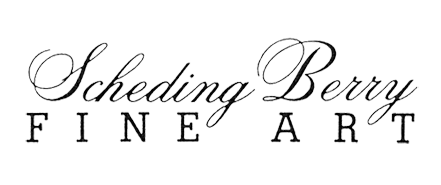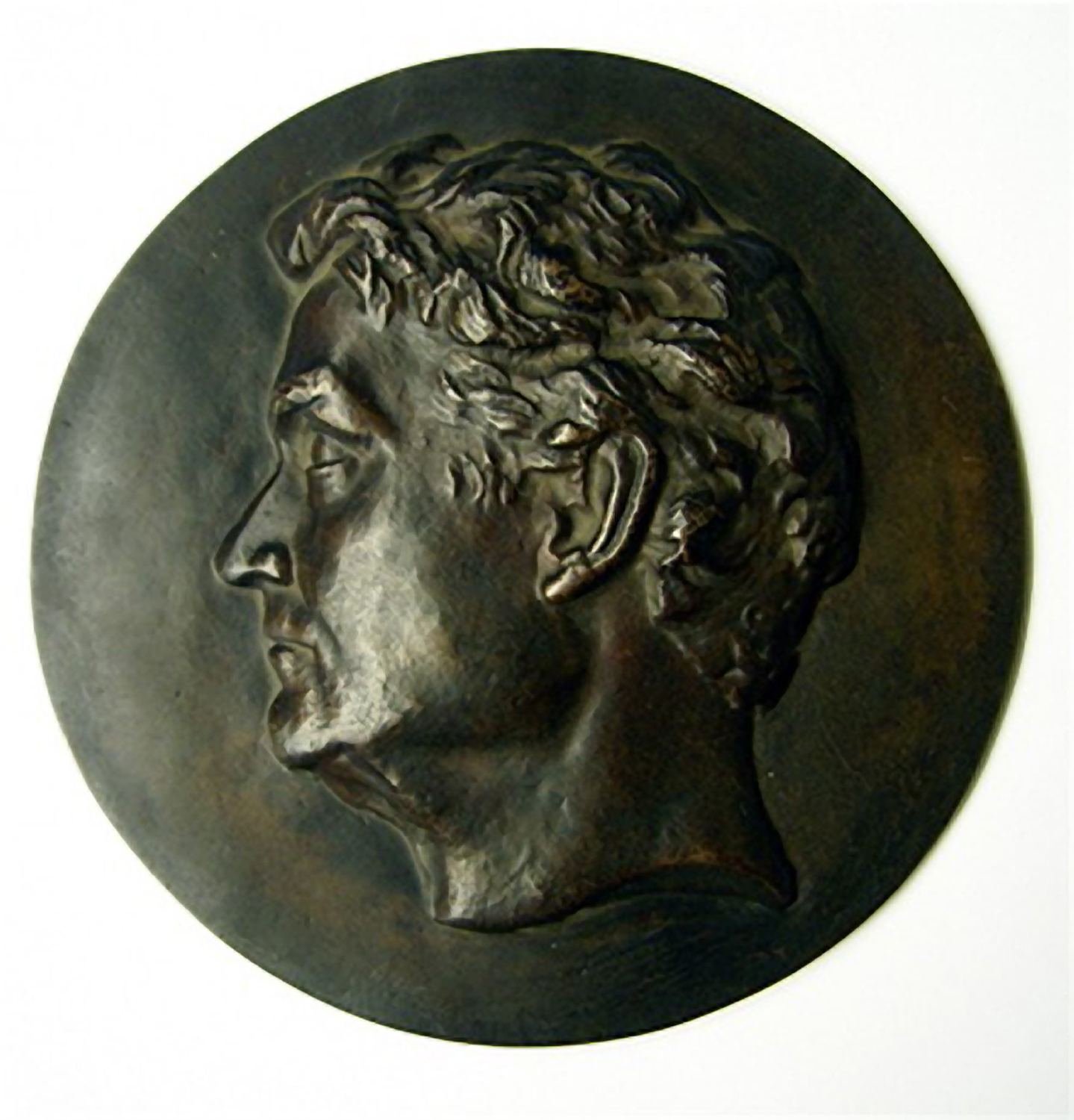Thomas Woolner
Portrait medallion of William Charles Wentworth
copper medallion, black paint
not inscribed
19.7
x 19.7
cm
SOLD
“An explorer, a master political manipulator, a barrister, a newspaper proprietor and a physical giant of a man who was afraid of nothing and no one, William Charles Wentworth was in every sense Australia's founding father. His story is the story of colonial Australia. Described by Manning Clark as 'Australia's greatest native son', William Charles Wentworth led a life of firsts. A man of rat cunning, great intelligence and sharp wit, he wrote the first book by an Australian to be published, was joint editor and proprietor of the colony's first independent newspaper, and founder of Australia's first university. But more importantly, with ruthless energy and a volcanic personality this 'convict brat' spent his life as an unrelenting advocate for comprehensive trial by jury, self-government and an Australian Confederation. Articulating a distinctly Australian identity to the world, he has a strong claim to be a founding father of modern Australia.” (This quotations is from publicity for Andrew Tink’s book William Charles Wentworth: Australia’s greatest native son, 2009, Allen & Unwin.)
From the Australian Dictionary of Biography entry (by Marjorie J Tipping):
"Thomas Woolner (1825-1892), was a student at the Royal Academy and exhibited there in the 1840s before meeting D. G. Rossetti and becoming an original member of the Pre-Raphaelite Brotherhood. ‘Woolner's attempts, however, to convey the principles of the Brotherhood through his sculpture produced few commissions’, contributing to Woolner's decision to visit the Australian gold diggings. He arrived in Melbourne on 23 October 1852 but after six months on the diggings returned to Melbourne to resume sculpting. He began to model clay medallions and then cast reliefs in bronze of well-known citizens, charging twenty-five guineas each. He received the patronage of Lieutenant-Governor Charles La Trobe which brought him several commissions. In 1853 some of his work was included in the exhibition of the newly formed Victorian Society of Fine Arts at the Mechanics' Institute. Woolner then spent six months in Sydney; later writing that the lovely scenery, the 'divine air' and the great amiability of every one towards him made it one of the most enjoyable periods of his life. Many leading citizens commissioned portrait medallions from him. He hoped to gain the commission for a statue of William Charles Wentworth and he decided to return to England to press his case. Woolner sailed for England in July 1854 in the Queen of the South, intending to return if he received the Wentworth commission. Instead he became one of the leading sculptors of his day as well as a poet of distinction. In 1871 he was an associate member and in 1875 a member of the Royal Academy, where he was appointed professor of sculpture; he resigned in 1879 before delivering any discourses. In all, he exhibited 120 works at the academy as well as at the British Institution and elsewhere. Among his best-known statues are those of J. S. Mill on the Thames Embankment, the Prince Consort and Bacon statues at Oxford, and Sir Stamford Raffles in Singapore. Among Australians whose likenesses he modelled were Lieutenant-Governor La Trobe, Sir Charles FitzRoy, Sir Charles Nicholson, Sir Redmond Barry, Admiral Phillip Parker King and several members of the G. W. Cole, Macarthur and Howitt families. Through (Sir) Henry Parkes Woolner was commissioned in 1874 to execute the colossal bronze statue of Captain James Cook for Sydney's Hyde Park. Woolner died on 7 October 1892 from an internal disorder after a short illness and was buried at St Mary's, Hendon. The Saturday Review obituary stated that 'few men of his generation had a greater fund of talk or a more telling delivery … he had, at one time or another, been the friend of almost every artist or every writer of his age."
The National Portrait Gallery website article by Michael Desmond, on the La Trobe plaque states that; In 1854 Woolner had met with Henry Parkes. The two maintained a correspondence and Parkes visited the artist in Britain in 1861 and 1882. Parkes assisted Woolner in securing the 1874 commission for the monumental bronze statue of James Cook that was erected in Hyde Park, Sydney. The Wentworth plaque was exhibited (probably in Melbourne) and The Argus review on 1 March 1854:
"The merits of the work are so decidedly above the level of what is met with in the colonies that we feel something more than a passing notice is required from our hands. The medallion, which is 9” in diameter, … that such a high class of work is likely to be spread abroad to educate the eye and refine the taste”. ( Graeme Sturgeon The Development of Australian Sculpture 1788-1975)
The following information relating to Woolner’s sculptures of Wentworth is from by Caroline Clemente’s article ‘Thomas Woolner’s Portrait Medallion of CJ La Trobe’ reproduced from The La Trobe Journal No 80, Spring 2007 (which is complete with endnotes).
[It was with] the hope of winning the commission for a statue of Wentworth to be judged in England, [that] Woolner returned to London in 1854, having honed his modelling skills and sharpened his marketing strategies in the colonies. He took home with him a case of plaster masters from which to produce portrait medallions in cast bronze… The reason Woolner returned to England with his precious baggage of plaster medallions was that there was no fine art bronze foundry in the colonies in which to cast his portraits. According to [sculptor] Peter Corlett, the process Woolner used would have been the lost wax method of casting. This involved taking a wax casting from a master plaster, packing it in heatproof material such as a mixture of plaster of paris and fireclay, and placing the mould in a kiln. Once all the wax was melted, molten bronze was poured into the mould to replace it. The cooling bronze in the firm packing solidified into the form of the original plaster medallion. This process caused a slight shrinkage between the diameter measurements of the plasters and the bronze medallions. The final product was then cleaned and chased in the studio under the eagle eye of its creator…
Woolner hoped that his prosperous colonial subjects would send to London for bronze casts of their portraits. The ploy of including famous names and public figures among his sitters worked remarkably well. Of his Australian portraits, in the popularity stakes Charles William Wentworth vied for top place with La Trobe, of whom there are 13 known bronze versions in public collections and private hands as well as what was probably the original plaster medallion, now preserved in the Pictures Collection of the State Library of Victoria. Having returned to Melbourne after a successful year in Sydney, Woolner departed for England on July 22, 1854, knowing that winning the Wentworth statue commission would give his career lift-off. [On 1 July 1855 a letter arrived] with Wentworth’s decision not to go ahead with his statue but to use the money instead for a fellowship of the College of Sydney…
Apart from those of WC Wentworth and La Trobe, Woolner’s 24 Australian medallion portraits, as listed by his wife Amy, include Admiral Philip Parker King, Sir Charles Nicholson, James Macarthur, George Macleay, Dr Bland, and Dr Howitt, his wife and children. Woolner had stayed with Howitt in Melbourne


